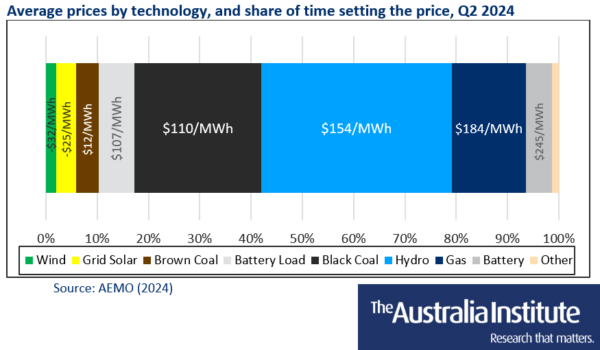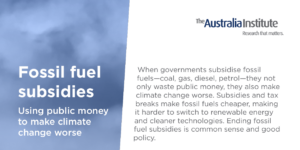We don’t need nuclear power – the path to cheaper electricity is renewables

The last thing Australia energy market needs is nuclear power. The data is clear – more renewables will lead to cheaper electricity.
Tomorrow the opposition leader, Peter Dutton, is discussing his plans to introduce nuclear power with anti-renewable energy commentator, Chris Uhlmann. No doubt we will hear the same claims about renewable energy causing electricity prices to be high and the need for nuclear power to keep prices down that both men have said in the past.
And just as was the case in the past, such claims will again be wrong.
The increased use of renewables in supplying electricity is not the cause of higher retail electricity prices – and it is clear that more renewables will lead to lower prices.
Research and data from the Australian Competition and Consumer Commission (ACCC), the Australian Energy Market Operator (AEMO), the Australian Energy Regulator (AER) and the CSIRO all make it abundantly clear that renewables are the cheapest form of electricity, and that the high cost of energy is driven by the cost of gas and coal produced electricity.
It is not surprising that people can be misled about the cause of electricity prices. Australia’s National Electricity Market (NEM) is a complex market stretching to 1,925 pages of rules and regulations such that any explanation of price determination will be greatly simplified.
So let us set out the two key issues to understanding retail electricity prices:
1. The cost of generating electricity (the wholesale price) is a surprisingly small component of the many costs that contribute to household electricity prices.
2. The wholesale price is rarely determined by the costs of generating electricity from wind and solar. Wholesale prices are most often determined by other forms of power generation, mainly fossil fuel sources, that are more expensive than most renewable generation.
According to the ACCC the wholesale price makes up only 33% of retail electricity prices. The other components that make up the retail price of electricity include network costs (transmission and distribution), retail costs and margins, and environmental costs

If wholesale electricity prices were to double then retail prices would increase a maximum of only 33% per cent. According to earlier ACCC research about two thirds of the increase in electricity prices over the last ten years caused the increase in transmission costs.
Renewables Do NOT SET Wholesale prices
Perhaps the most confusing aspect of the NEM is how prices are set (so much so that websites like Wattclarity can devote themselves to disentangling what is going on!)
Under the NEM a complex bidding process occurs across six, partially connected, markets. Essentially this involves electricity generators offering bids to supply a set amount of electricity at a certain price.
So if you generate electricity from a coal-fired power station, you might offer to supply 1,000MW at $110 per MWh while a company that generates power from wind farms might offer to sell 1,000MW at $5 per MWh, and a gas-fired power station operator offers 1000MW at $184MWh.
If the market needs 2,200MW, they will first take 1,000MW from the wind farms because that is the cheapest, then 1,000MW from the coal-fired generator and lastly it will take 200 from the gas-fired station. But because the energy from the gas-fired power station was the last (most expensive) source, it determines the wholesale price. So despite supplying just 8% of the electricity in this example, it the entire wholesale price is $184MWh!
The important point is that for renewables to be the source of higher wholesale prices renewables would also have to be the most expensive form of generation. Whereas the opposite is true.
Research from the CSIRO reveals that renewables are some of the cheapest forms of generation. On the other hand, fossil fuel sources, in particular gas, are some of the most expensive forms of generation behind the most expensive; nuclear. This would mean if nuclear was in the system and it was the last supplier of energy into the system, it would determine the wholesale price. Little wonder that reports out this week suggest that were Australia to have nuclear power as proposed by Peter Dutton, electricity prices could rise $665 a year.

Recent data from AEMO outlines more precisely which generators set the wholesale prices in the NEM over the June quarter of 2024.
This is a particularly important time period because wholesale prices increased 76% in that quarter, and politicians to the CEOs of supermarket chains blamed renewables. The data however shows that over the entire three months of April, May and June this year, wind and solar rarely set the wholesale price and when they did the prices were very low, often negative.

The wholesale price was most often set by fossil fuels and at prices greatly higher than wind and solar.
Gas-generated power sets some of the highest prices and for a considerable amount of time. Despite setting a whopping average price of $184 MWh, 15% of the time, it supplied only 7% of total power in the quarter. That is considerable price-setting power. Clearly, renewables cannot be the main determinant of increases in wholesale electricity prices if they rarely set the price.
AMEO noted in its report three main reasons for the jump in prices in the June quarter:
1. Wind and rainfall drought – lower wind and hydro supply availability.
2. Transmission outages – planned and unplanned.
3. Price volatility from transmission outages.
This suggests that one of the big causes of high electricity reprices was the lack of renewables. Because of the lack of wind power available, the prices of more expensive forms of electricity played a greater role in determining prices, particularly expensive gas-fired electricity.
The AER was even more forthright. It noted:
Prices increased due to a combination of higher demand, network and generator outages, and lower wind and solar output increasing the share of electricity generated by higher-priced gas and hydro.
This means the best way to reduce electricity prices is to:
- reduce demand for electricity through energy savings measures that reduces the periods when the wholesale price is set by expensive fossil-fuel generation such as gas.
- increase production of renewables – so that it can more regularly be the price setter in the system.
Despite what you might hear tomorrow, or from others, the key to lower energy prices is not nuclear, let alone more gas, but much, much more renewable energy. While the energy market continues to rely on gas and coal, Australians will continue to pay higher prices for their electricity, and if nuclear were ever to come into the system, the price would jump even higher.
Between the Lines Newsletter
The biggest stories and the best analysis from the team at the Australia Institute, delivered to your inbox every fortnight.
You might also like
Dutton’s nuclear push will cost renewable jobs
Dutton’s nuclear push will cost renewable jobs As Australia’s federal election campaign has finally begun, opposition leader Peter Dutton’s proposal to spend hundreds of billions in public money to build seven nuclear power plants across the country has been carefully scrutinized. The technological unfeasibility, staggering cost, and scant detail of the Coalition’s nuclear proposal have
Fossil fuel subsidies
When governments subsidise fossil fuels—coal, gas, diesel, petrol—they not only waste public money, they also make climate change worse. Subsidies and tax breaks make fossil fuels cheaper, making it harder to switch to renewable energy and cleaner technologies. Ending fossil fuel subsidies is common sense and good policy.
The hands of the Doomsday Clock show the world is ignoring a potential three-headed catastrophe
The apocalyptic “the end is nigh” was a popular meme for the image of despair and exclusion from the accelerating prosperity of America and the West.



